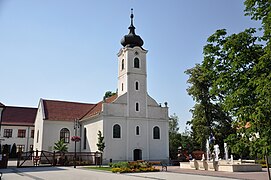Gödöllő
| Gödöllő | ||||
|
||||
| Basic data | ||||
|---|---|---|---|---|
| State : | Hungary | |||
| Region : | Central Hungary | |||
| County : | pest | |||
| Small area until December 31, 2012 : | Gödöllő | |||
| Coordinates : | 47 ° 36 ′ N , 19 ° 22 ′ E | |||
| Area : | 61.97 km² | |||
| Residents : | 34,396 (Jan. 1, 2011) | |||
| Population density : | 555 inhabitants per km² | |||
| Telephone code : | (+36) 28 | |||
| Postal code : | 2100 | |||
| KSH kódja: | 32559 | |||
| Structure and administration (status: 2014) | ||||
| Community type : | city | |||
| Mayor : | György András Gémesi (GLK - Gödöllői Lokálpatrióta Klub) | |||
| Postal address : | Szabadság tér 7 2100 Gödöllő |
|||
| Website : | ||||
| (Source: A Magyar Köztársaság helységnévkönyve 2011. január 1st at Központi statisztikai hivatal ) | ||||
Gödöllő [ ˈgødølːøː ] ( German Getterle ) is a town in Pest County, Hungary .
location
Gödöllő is located approx. 30 km northeast of Budapest , covers an area of 6,198 hectares and has 34,396 inhabitants (as of 2011).
history
Two grave finds near Gödöllő prove a settlement already in the transition from the spring Latène (LTB II) to the middle Latène (LTC I), around 399 to 200 BC. The most important find is a sword with the upper part of the sword scabbard, which is decorated with gold- encrusted animal heads. The find is now in the Hungarian National Museum (Magyar Nemzeti Múzeum).
The area of the village was verifiably sparsely populated since the 14th century; the already small population decreased even further during the Turkish rule (from 1541).
The rise of Gödöllő began in 1737, when the village was acquired by the important Hungarian landowner Antal Grassalkovich I , who had Gödöllő Castle, Hungary's largest baroque palace, built here since 1741 as the ancestral seat of his family . The village also benefited from his creative drive: through buildings, the settlement of German craftsmen and market rights in 1763.
After the fall of the Grassalkovich family, the Hungarian state finally acquired the estate and gave it to the (Austrian Emperor and Hungarian) King Franz Joseph I as a gift for the coronation ceremony following the Austro-Hungarian Compromise in 1867 . The frequent visits of the ruling couple and especially Queen Elisabeth led to an upswing in Gödöllő as a glamorous summer resort for Budapest aristocratic families with all the associated infrastructure. The town retained this function on a smaller scale in the interwar period as the summer residence of the Hungarian ruler Miklós Horthy .
During communist rule, in order to soften the “ bourgeois ” impression of the place, a lot of industry was settled, but also the headquarters of the Szent István University in Gödöllő.
Since January 1st 1966 Gödöllő has city rights.
After the fall of the Wall in 1989, the city had to cope with the difficult process of transformation towards a service society. After the last Soviet troops quartered in the royal palace withdrew in 1990, it was largely restored and converted into a cultural center. Rooms in the castle can be rented for festivities (e.g. weddings).
Sights and leisure
- Grassalkovich Castle
- reformed Church
- Basilica of the Assumption in Máriabesnyő, built in the 1760s
- Gödöllői Kisvasút , museum railway
The Hungaroring for Formula 1 races, including an adventure park, was built near Gödöllő . Closest seaside resorts: amusement park near Hungaroring and Veresegyház .
gallery
Town twinning
-
 Aichach , Germany
Aichach , Germany
-
 Bad Ischl , Austria
Bad Ischl , Austria
-
 Bogor , Indonesia
Bogor , Indonesia
-
 Giessen , Germany
Giessen , Germany -
 Laxenburg , Austria
Laxenburg , Austria -
 Turnhout , Belgium
Turnhout , Belgium
-
 Valdemoro , Spain
Valdemoro , Spain
-
 Wageningen , Netherlands
Wageningen , Netherlands
literature
- Franz Weller: The imperial castles and palaces in words and pictures. Hof-Buchdruckerei, Vienna 1880. ( Online )
Web links
Individual evidence
- ↑ Miklós Szabó / Eva Petres: Decorated Weapons of the La Tene Iron Age in the Carpathian Basin. Inventaria Praehist. Hungariae V, Budapest 1992; In: Susanne Sievers / Otto Helmut Urban / Peter C. Ramsl: Lexicon for Celtic Archeology. A-K ; Announcements of the prehistoric commission published by the Austrian Academy of Sciences , Vienna 2012, ISBN 978-3-7001-6765-5 , p. 651.






